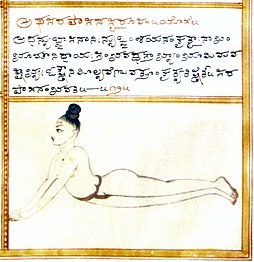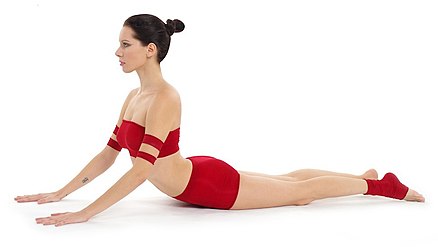Bhujangasana

Bhujangasana(Sanskrit:भुजंगासन;IAST:Bhujaṅgāsana) orCobra Pose[1]is a reclining back-bendingasanainhatha yogaand modernyoga as exercise.It is commonly performed in a cycle ofasanasinSurya Namaskar,Salute to the Sun, as an alternative toUrdhva Mukha Svanasana,Upward Dog Pose. TheYin Yogaform isSphinx Pose.
Etymology and origins[edit]
The name Bhujangasana comes from the Sanskrit words भुजंगbhujaṅga,"snake" and आसनāsana,"posture" or "seat", from the resemblance to a snake with its head raised;[2]it was described in the 17th centuryhatha yogatextGheranda Samhitain chapter 2, verses 42–43. In the 19th centurySritattvanidhi,the pose is named सरपासनSarpāsana,"Serpent Pose", from सरप,sarpa[m],"serpent" or "snake".[3]Yogi Narayana Ghamande described and illustrated the pose inhalftoneas Bhujangasana in the 1905Yogasopana Purvacatuska.[4]
Urdhva Mukha Shvanasana (Sanskrit:ऊर्ध्वमुखश्वानासनIAST:Urdhva mukha śvānāsana) is from the Sanskrit ऊर्ध्वUrdhva,"upwards"; मुखMukha,"face"; and श्वानShvana,"dog".[5]The pose is one of those (along withDownward Dog) introduced byKrishnamacharyain the mid-20th century fromSurya Namaskar,Salute to the Sun. That exercise was not until then considered to be yoga. It was later taught by his pupilsPattabhi JoisandB. K. S. Iyengar.[6][7]
-
Acobrawith its hood raised.
-
Sarpasana, Serpent Pose, in theSritattvanidhi
-
Bhujangasana inYogasopana,1905
Description[edit]
The pose may be entered from aprone positionor fromDownward Dog.The palms are placed under the shoulders, pushing down until the hips lift slightly. The backs of the feet rest on the ground, the legs outstretched; the gaze is directed forwards, giving the preparatory pose. For the full pose, the back is arched until the arms are straight, and the gaze is directed straight upwards or a little backwards. In Bhujangasana the legs remain on the ground, whereas in Upward Dog the hips, thighs and knees are lifted slightly off the ground.[8][9][10]Salabhasana,Locust pose, or Sphinx pose can be used to prepare for bhujangasana.[11]
Bhujangasana is part of the sequence of yoga postures in some forms ofSurya Namaskar,the Salute to the Sun.[12]Balasana,child's pose, is a counter pose for bhujangasana.[11]
Variations[edit]
An easier variant is Sphinx Pose, sometimes called Salamba Bhujangasana (षलम्ब भुजंगासन),[13]in which the forearms rest on the ground, giving a gentler backbend.[14]It is used in the long holds ofYin Yoga,either with the forearms on the ground or with the arms straightened.[15]
The pose can be modified, for instance,in pregnancy,by placing a blanket under the pelvis.[15]
Urdhva Mukha Shvanasana, Upward Dog, is entered with an inhalation from a prone position (or fromChaturanga DandasanaorAshtanga Namaskarain a Surya Namaskar cycle), taking the feet a little apart. The legs are stretched out straight, the toes out (not tucked under), and the weight of the body is supported on the hands with outstretched arms so the hips are off the ground. The gaze is directed straight upwards, so the neck and back are arched.[5]
-
Variant with less extremebackbend
-
Yin Yoga's Sphinx pose, an easier variant
-
Urdhva Mukha Shvanasana, Upward Dog Pose, has the hips off the ground.
See also[edit]
- Makarasana,Crocodile pose, reclining
References[edit]
- ^Anon (28 May 2007)."Cobra Pose".Yoga Journal.
- ^"Bhujangasana, Bhujanga-asana, Bhujaṅgāsana: 2 definitions".Wisdom Library.Retrieved6 June2023.
- ^Sjoman, Norman E.(1999) [1996].The Yoga Tradition of the Mysore Palace(2nd ed.). Abhinav Publications. p. 71.ISBN81-7017-389-2.
- ^Ghamande, Narayana (1905).Yogasopana Purvacatuska(1st ed.). Bombay: Janardan Mahadev Gurjar, Niranayasagar Press. p. 77.
- ^abMehta 1990,p. 91.
- ^Singleton 2010,pp. 204–205.
- ^Singleton, Mark(4 February 2011)."The Ancient & Modern Roots of Yoga".Yoga Journal.
- ^Iyengar 1979,pp. 107–108, 396–397.
- ^"Urdhva Mukha Shvanasana".AshtangaYoga.info.Retrieved2011-04-11.
- ^"Upward-Facing Dog | Yoga Poses".Yoga Journal.18 October 2008.Retrieved2 August2013.
- ^abDehnke, Andrea (28 August 2007)."Cobra Pose".Yoga Journal.Retrieved30 July2022.
- ^"Surya Namaskara".Divine Life Society.2011.Retrieved19 July2019.
- ^"Sphinx Pose -Salamba Bhujangasana".Ekhart Yoga.Retrieved4 February2019.
- ^Anon (28 August 2007)."Sphinx Pose".Yoga Journal.Retrieved4 February2019.
Sphinx Pose is the infant of backbends.
- ^ab"Sphinx & Seal".Yin Yoga.Retrieved26 July2019.
Sources[edit]
- Iyengar, B. K. S.(1979) [1966].Light on Yoga.Thorsons.ISBN978-1855381667.
- Jain, Andrea(2015).Selling Yoga:from Counterculture to Pop culture.Oxford University Press.ISBN978-0-19-939024-3.OCLC878953765.
- Mehta, Silva; Mehta, Mira; Mehta, Shyam (1990).Yoga: The Iyengar Way.Dorling-Kindersley.
{{cite book}}:CS1 maint: multiple names: authors list (link) - Newcombe, Suzanne(2019).Yoga in Britain: Stretching Spirituality and Educating Yogis.Bristol, England:Equinox Publishing.ISBN978-1-78179-661-0.
- Singleton, Mark(2010).Yoga Body: the origins of modern posture practice.Oxford University Press.ISBN978-0-19-539534-1.OCLC318191988.









